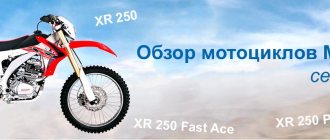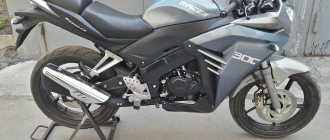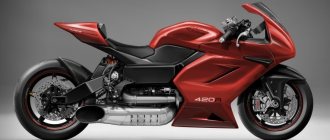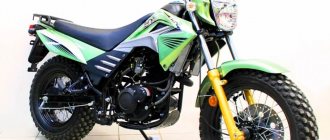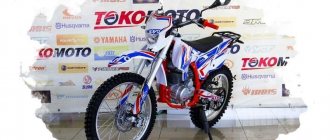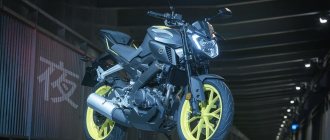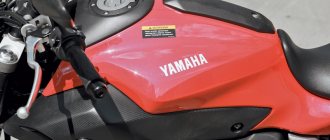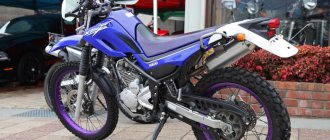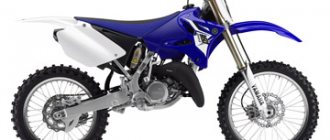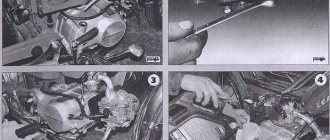Yamaha TZR 50 motorcycle is a lightweight sports bike (motorbike). In the category of 50 cc motorcycles of this type (sport), only the Italian Aprilia RS 50 can compare with it in the fight for the best design and the admiration of fans.
Japanese engineers did their best. Even with a minimum engine capacity of 50 cubic centimeters, this motorcycle is water-cooled, electric starter, separate lubrication, 5-speed gearbox and all disc brakes.
Comparing this model with the more powerful version of the TZR, namely the Yamaha TZR 125, we can say that the design of this motorcycle was not copied from its older brother. Yamaha TZR 50 looks sportier and more colorful.
Twin headlights, clean lines, perfectly coordinated plastic body kits, all this and much more makes this motorcycle unique in its category. Some people, looking at this bike, cannot believe that it is just a 50 cc moped.
In addition to excellent Japanese build quality, a fairly good selection of components (tires, spark plugs, etc.), the Yamaha TZR 50 motorcycle can easily be improved, adjusted and tuned. In order to save engine life, the new bike has a limit or so-called “cut-off”, so the maximum speed is within 50-60 km/h.
For those people who want to get maximum opportunities and adrenaline, it must be said that this motorcycle can be safely and without any problems “accelerated” to 100 kilometers per hour. Watch various videos on YouTube to prove this.
In addition to a whole “field” of possibilities for tuning, this bike does not require a category “A” driver’s license. You can ride it in Russia without a license (at least for now). All mopeds, scooters and motorcycles up to 50 (49.9) cubic meters do not need to be registered.
What should be the choice
And yet the Yamaha TZR 50 is a full-fledged sports bike that all young aspiring riders dream of. It is generally accepted that one should enter the world of road racing on a motorcycle with an engine capacity of no less than 750 cc, and even better if the biker has a liter car under him. More sober potential racers call the engine volume 400 or 600 cubic centimeters. Neither one nor the other is right. All these cars, due to their super-powerful motors, easily get out of control. And then an inexperienced motorcyclist can find himself in a difficult situation, even leading to an accident.
A little about the manufacturer
Yamaha is one of the world's vehicle manufacturers. In particular, scooters, which are often found on city streets in the summer. Surely, you have already heard about this manufacturer, right?
Yamaha production originates from Japan, so the company's vehicles are distinguished by high quality and long service life. The manufacturer uses high-quality components and spare parts, which ensures a long service life.
What is the intent of Japanese designers?
The Yamaha TZR 50 motorcycle, whose speedometer looks rather modest - the scale is marked from zero to 60 km/h, at first arouses distrust among future athletes and race track conquerors. Like, what kind of sportbike is this, on which you crawl at a speed of sixty kilometers per hour! However, the Yamaha TZR 50 model is designed for that; the machine is an ideal trainer for novice riders.
Advantages and disadvantages of Yamaha scooters
Scooters from this manufacturer, like all other vehicles, have their advantages and disadvantages. Knowing about them in advance is much more useful than identifying them after the purchase, isn’t it? For this reason, we will outline the main pros and cons so that you can form the right expectations before purchasing.
Advantages:
- easy handling;
- fast acceleration;
- economical fuel consumption;
- comfort while driving;
- nice appearance.
Advantage or disadvantage
Low speeds are what you need to acquire driving skills. Assessment of the road situation, speed of reaction, the ability to make the right decisions - all this is best instilled when riding a Yamaha TZR 50. Driving practice is reinforced by the motorcycle itself, the parameters of which fully correspond to the driving characteristics of full-size racing cars. Weight, transmission, wheels and structural balancing. Everything except the “toy” motor.
Features of Yamaha scooters
It should be noted that all models have an elegant appearance, which is combined with elegance of execution. As confirmation, you can look at photos of scooters on the Internet. They really look quite beautiful and pleasant, which means they attract attention and are a pleasure to ride.
Most often, lovers of safe and at the same time fast riding consider the Yamaha 50cc scooter. Typically, 50 cc engines are the best option for city driving.
In the rating of scooters from this manufacturer, the most popular are the Yamaha Aerox R and Yamaha Jog. The first option has a sporty direction and is well suited for tuning. It holds up well on the road under high loads. Capable of reaching speeds of up to 70 km/h, which is quite high for a scooter.
The second option, Yamaha Jog, is suitable for everyday driving and is characterized by increased reliability. Its peculiarity is that throughout the production of the unit, it did not undergo much changes. According to real users of this product, it is one of the best in its class among all 2-stroke classic 50 cc engines. In addition, it is suitable for both young people and older people. In general, it covers all categories of citizens for whom Jog can be useful in everyday life.
There is also a UAV model, which is ideal for driving over rough terrain due to its wide wheels and high ground clearance. Look at her too.
Yamaha TZR 50: technical specifications
The motorcycle data is largely controversial. There is a discrepancy between the engine power and the chassis. However, in general, the characteristics allow its operation.
Below are the main parameters of the motorcycle:
- type of motorcycle - sports, low power;
- maximum power - 2.7 liters. s., when the crankshaft rotates at a frequency of 6250 rpm;
- engine - two-stroke, single-cylinder;
- working volume - 49 cubic centimeters;
- transmission - six-speed gearbox with lever-type foot shift;
- rear wheel drive - chain, open;
- power supply system - carburetor, PHBN 16 Carburettor;
- cooling - water, closed circuit with forced pumping;
- distance between axles - 1341 mm;
- ground clearance - 151 mm;
- height along the saddle line - 815 mm;
- brakes - disc, ventilated;
- Wheels - titanium, light alloy;
- front suspension - reverse, fork with hydraulic shock absorbers;
- rear suspension - articulated pendulum, spring with hydraulics;
- engine starting - electric starter;
- electrical circuit - six-volt circuit, with a recharging generator and battery;
- electrical consumers - a complete set for night operation, turn signals, brake light, high beam headlight, instrument and speedometer illumination;
- gas tank capacity - 13.8 liters;
- speed close to maximum - 50 km/h;
- dry weight - 114 kg.
The Yamaha TZR 50 motorcycle, whose characteristics generally meet Japanese quality standards, is highly valued in the market.
Test drive YamahaTZR 50
What should be the first step into the world of sportbikes? There are descendants of kamikazes who claim that you can start with a “liter”. People who are more sober-minded, but not sophisticated, believe that 750 cubic meters is much safer. The most advanced ones wisely call the numbers 600 and 400 cm3. The last option for an adult guy will not be bad, but what should young adepts of sport biking who haven’t really received their “rights” do?
It’s a good idea to master entry-level technology, which, fortunately, is also available on our market.
The Yamaha TZR 50 looks very grown-up. By and large, from a distance of fifteen meters it can easily be mistaken for an R6 of the first series or a Thundercat. The stamped steel frame, painted black, very convincingly imitates the “diagonal”. The sharp plastic design and AJP brake calipers painted gold (well, Brembo Oro!) add to the bike's solidity.
In short, if you don’t yell “I’m driving half a grand” into a megaphone, then you can seriously splurge. At first I thought that I was the only one so impressionable, but when at the gas station the employees began to find out in all seriousness “how much he eats and how hard he rushes,” I realized that the “turnover ratio” (demonstrating how many passers-by will turn to look at the bike) is TZR- ki is extremely high!
The engine starts, as they say, right off the bat and does not give any indication of its operating condition. Just when I began to doubt whether everything was in order, a gust of wind brought a cloud of snow-white two-stroke exhaust, enriched with oil for the break-in period. That's the same! First gear engages softly, I give the gas and... Uh-uh, nothing happens! The engine in the break-in configuration begins to pull only from 4-5 thousand revolutions. In the first four gears we managed to accelerate to 50 km/h! Moreover, as practice has shown, it is impossible to achieve higher speeds in any of the gears, so in 4th you can cut like an automatic.
However, on the tightly clogged Kyiv ring road this does not interfere at all: 50 km/h in the aisles is what the doctor ordered. Leaning comfortably on the tank, I continue to form an opinion about the bike. The seat is hard, tailored according to sportbike canons. The steering wheel, as expected, is set low, the footpegs are set back. Meanwhile, the ergonomic triangle turned out to be very successful, except that “vomiting” at the speed of a stung cyclist is not very comfortable, and it may be uncomfortable for those who use excessive acceleration.
Unlike a two-stroke engine, the brakes on this Yamaha do not require gentle running-in. After a short grinding in, they are ready to show everything they are capable of. The 280 mm front brake and two-piston caliper look like a toy, but they are enough to put the lightweight (114 kg dry weight) bike on the front wheel. The rear disc has a diameter of 220 mm, so it should not be neglected if necessary.
Break-in is a sacred thing for any motorcycle, let alone a two-stroke engine! But what kind of test is this if you don’t give the baby “soot”? A thorough audit among friends revealed one TZR-man, who became our unwitting “victim”. Well, what can I say, a motorcycle that has been run in and properly “perfumed” makes a completely different impression. Active operation of the gearbox makes it possible to understand that the content here is quite consistent with the combat appearance. Furiously thrashing its single cylinder, the Yamaha dramatically “falls” through reality.
The modest engine size leaves its mark on the driving style, forcing the gearbox to work furiously. Up and down, up and down. It’s nice that this manner on this motorcycle not only does not irritate, but is perceived as the only acceptable one, as if passion awakens in you, and you tirelessly click the shutter, squeezing all the juice out of this “half a grand.” All juice is about 100 km/h on the speedometer, and with a tailwind - 105-107 km/h. Keeping in mind that this “ambitious” sportbike has an engine capacity of only a quarter of a glass, the result can be considered simply excellent. In almost all modes (within reason), the bike behaves excellently; the brakes are off the charts.
Riding this, in general, children's motorcycle is exciting, forgive the tautology, not childish. On the other hand, driving in the city revealed one peculiarity: while driving the TZR50 you don’t want to use the brakes at all, it’s such a pity to lose the speed gained in an unequal struggle with the gearbox and aerodynamic drag. You get the peak pleasure from riding this bike on the go-kart ring, where you have the opportunity to ride in optimal mode without wasting a crumb of power.
At the end of the test, I suddenly thought that, unfortunately, in the years of my foggy youth, I couldn’t even dream of a real sportbike in miniature, a kind of “desk” for a beginner. I think any boy will get great pleasure from his first kneeling turn in his life, and the Yamaha TZR50 is able to fully satisfy the needs of a beginner. A picture involuntarily crept into my head showing a dozen and a half TZRs on the starting grid of the track, the concentrated faces of the racers taking the start of the first real race in their life... Monocup, the forge of future champions?! Why not! The Yamaha importer has the floor!
Text: Denis Los
Photo: michel
Impressions of motorcyclists
Reviews from Yamaha TZR 50 owners are generally positive. Many people note that the engine starts with a quarter turn. The starter works silently, and it only works for half a second. The two-stroke engine knocks lazily but evenly. First gear engages unusually softly, the clutch is smooth. But it’s impossible to move at medium speeds. It is necessary to increase the gas and reach a rotation speed of 5 thousand: from this figure the engine begins to thrust.
By switching the box in different combinations, you can reach a speed of fifty kilometers per hour. This is the limit for the Yamaha TZR 50 motorcycle. And the point is not in the low power of the motor, but in the limiters that are installed during assembly. It turns out that if you remove the lock, the speed increases to 100 km/h. No one yet knows how to explain this phenomenon.
Further, motorcyclists express the belief that if you do not pay attention to the engine, then the rest of the car leaves a positive impression of itself. A very comfortable ergonomic seat that can be used in several positions. One of them is “lying on the tank”, it is used by racers at speeds of over two hundred kilometers per hour. Perhaps this is a calculation for the future.
The steering wheel, according to the owners of the motorcycle, is also designed perfectly, in accordance with racing standards. The rod is located low, the distance between the ends is minimal. The footpegs are optimally positioned so the rider's legs don't get tired.
The brakes evoke a feeling of respect among everyone: the front disc is 280 mm in diameter, the rear disc is 220 mm in diameter. The two-piston caliper design allows you to “put” the motorcycle on the front wheel, its operation is so efficient. If you brake in full mode, the Yamaha TZR 50 will stop rooted to the spot at any speed, even the maximum - 49 km/h. At the same time, there is no skidding or skidding. Wide tires with developed tread provide ideal grip on the road.
Hi all! It’s still winter, and in order to pass the time until the next season, I decided to write about how I got to the 2-wheel life, and how it started for me Back in 2010, almost at the end of summer - more precisely, in the month of August, I had accumulated a certain amount of money, which I decided to spend usefully and on entertainment at the same time. I decided that it would be a good idea to buy myself a scooter so that I could get to work without having to rely on public transport. Also, back then you could still ride them like a bicycle - without a license, which undoubtedly added to the attractiveness. And so, in the process of looking at advertisements for the sale of 2-wheeled vehicles on the city website, he was accidentally noticed. A previously unknown to me 2-wheeled unit with the appearance of a real sports motorcycle: a characteristically defined tail, rear suspension with a mono-shock absorber, a protruding flat tank, low clip-ons instead of a handlebar, and a full plastic aerodynamic fairing. It also had a 6-speed manual transmission with a manual clutch, hydraulic disc brakes front and rear, liquid cooling, an incredible marking of up to 140 km/h on the speedometer, and a red zone of up to 14 thousand on the tachometer. Everything is like real motorcycles! And even with the big name Yamaha! At the same time, the volume was listed as 50cc, which also made it possible to drive without a license. Scooters immediately disappeared from my imagination and never returned there... And I started looking for what kind of model this was - I didn’t find much information, except that it is 2-stroke and thanks to this it has a real opportunity to accelerate to at least 100 km/h (scooters of the same volume smoke nervously on the sidelines). It was decided to go sit and have a look the next evening. A work colleague was invited who owns a Suzuki GSX-R 750 and clearly knows more about motorcycles than I do, as well as a friend of my colleague who drives a Yamaha Dragstar chopper with customization elements. It was just such a stern company that they came to the seller. It quickly became clear that this unit had been serviced by a well-known city motorcycle repairman (Alexander Abzalov, of blessed memory) whom we immediately called and found out everything about the condition and price compliance. They asked for 50 thousand rubles for it. The rear brake foot was not screwed on (the pin was lost), and there were also complaints about the rear shock absorber. On the plus side, there was a sports ignition switch without a cutoff, a fanned intake and a tuned carburetor, thanks to which the maximum speed was as much as 120 km/h
This is what he looked like when we first met. Having negotiated the price for 5 thousand and borrowing the missing amount, I came 3 days later to pick up the gazelle - since it was not possible to drive through half the city on my own. I unloaded it in the parking lot near the house, and the next morning I ran to learn how to drive, in an empty parking lot at the nearest car dealership. Since before this I had never ridden a motorcycle, even a Soviet one, I read on the Internet the sequence to start moving: clutch, then first down, then gas and release the clutch. Then I kept stalling, forgetting to remove the step (who knew there was a sensor there) and after some time I managed to move off! I’m driving 5 km/h in a straight line, I don’t touch the gas, but I feel like I’m about to take off))) I’m still braking with my feet, making a U-turn with a radius across the entire parking area - in a word, I’m learning. I rode like this for 2 weeks, getting used to the controls, starting and working with the gearbox. In the process of gradually spinning up the engine, which began to go from 3 thousand, it was found that when the tachometer needle reaches 8 thousand, it suddenly and VERY SHARPLY shoots out, as if a turbine was turning on, the revolutions with a roar exceed 12 thousand, and the motorcycle accelerates abruptly with 15 to 40 km/h is so breathtaking, and all this within one gear in less than a second! Later, when I got used to it and got used to clicking speeds between 10-12 thousand, I easily left the traffic lights first. And below 8 thousand there is practically no thrust... But it was precisely this explosive character with a pronounced pickup that I really liked, and some YBR125 seemed terribly sluggish and boring, despite twice the engine capacity. The TZR is also very light, and turns literally with the power of thought - there is a minus to this, it blows away a lot on the highway, but still the ease with which you can drive, especially through traffic jams in the city, is extremely pleasant. I don’t even know if I’ll be able to switch to a heavier motorcycle in the future.
In addition, the first day behind the wheel I will forever remember my shoulders and neck being terribly sunburnt in the sun, and since then I have never driven without equipment. And then there was the first trip to the city, the first almost accident and the first fall, but more on that next time.
